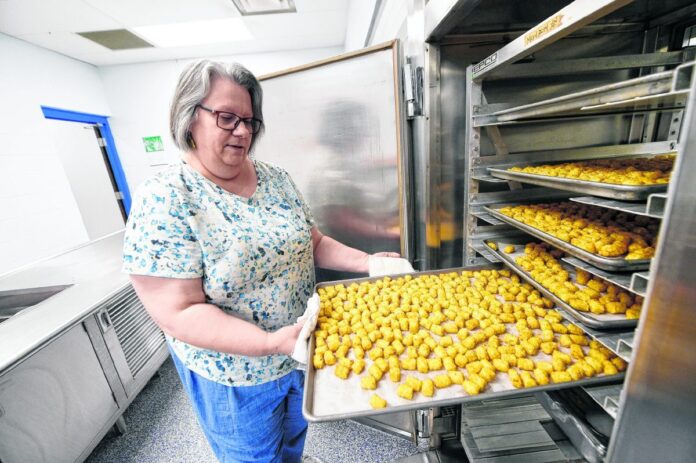
HANCOCK COUNTY — A food order for Mt. Vernon High School last week included 54 different items, nearly half of which were out of stock.
Similar situations have been unfolding at schools across the county as they experience the effects of food shortages, from provisions including lettuce and meat to materials like the plastics that make up beverage bottles. As the industries of food production and distribution continue starving for workers, school officials are adapting to the resulting supply chain slowdowns by modifying menus as best they can.
Amanda Stout, director of food services for Greenfield-Central schools, said fresh romaine lettuce is one of the items the district is struggling to acquire.
“What we’re being told is that there’s not even enough farmhands on the farms to help pick the product,” she said.
The school corporation is also feeling the effects of a chicken shortage. Stout said chicken was doing well at the beginning of the academic year in Indiana, where schools typically start sooner than much of the rest of the Midwest. That changed, however, as more schools opened elsewhere.
“The supply is just not there to meet the demand,” Stout said.
She said when anticipated foods can’t be acquired, menus have to be modified, sometimes on the same day as the meals.
Stout added that a plastic bottle shortage is resulting in less sports drinks and soda as well.
A lack of labor throughout the various facets of food production and distribution can lead to the kinds of shortages schools are experiencing, she said.
“If a piece of equipment in the manufacturing process happens to break down, and they can’t source the technician to fix the machine or parts, then production is put at a halt or minimum output at that point,” she added.
The food shortages started during the 2020-21 school year and have worsened ever since.
“We were struggling a little bit last year, but by no means was it this difficult,” Stout said. “Thankfully, we have good partnerships with our vendors, and they let us know ahead of time when products are delayed or halted.”
The school corporation is able to substitute lacking menu items for something similar in order to continue providing students with meals and choices. Stout said while Greenfield-Central has to follow certain nutritional guidelines to make meal costs reimbursable through the federal government, the U.S. Department of Agriculture has also granted waivers for the free school meals it provides for due to the supply chain issues. For example, white bread can be offered if a whole-grain item is unavailable. The same goes for 2% milk when there’s not enough 1% to go around. There are more flexibilities with sodium restrictions as well.
Doris Johnson, food services director for Mt. Vernon schools, told the Daily Reporter in an email that there’s currently a national shortage of a number of foods available to schools, including dinner rolls, buns, chicken products, beef products, fresh and pre-packaged produce, juice, water, condiments and paper products.
Johnson said she understands some of the supply chain challenges originated from slower manufacturing due to the COVID-19 pandemic.
“Now, food processing plants, warehouses and delivery companies are experiencing labor shortages, much like the food service department at Mt. Vernon,” she said.
The school corporation is adapting by trying different vendors and stores, having to buy more expensive items and cutting back on menu items, Johnson said.
Like Greenfield-Central, Mt. Vernon also started experiencing the shortages during the last school year, and they’ve gotten far more substantial ever since.
The same is true for Eastern Hancock schools, said Tracy Wilson, the district’s food service director. She told the Daily Reporter in an email that she’s seeing shortages in just about every kind of food.
“We spend hours each week trying to find substitute items that students will like and that will satisfy the federal guidelines schools are required to follow,” she said.
Examples of shortages that come to mind include main entrees, canned or frozen fruits and vegetables, other side items and condiments.
“It’s even becoming a challenge to find the extra a la carte items that students can purchase such as bottled water or juice and healthy snacks,” Wilson said.
She also hears the shortages are due to a decrease in the labor force.
“Growers/producers, transportation companies and distributors are all struggling to find employees,” she said. “Without employees the industry can’t keep up with the demand.”
As at Greenfield-Central and Mt. Vernon, the situation calls for significant adaptations.
“We are continually changing our menu to reflect what we are able to purchase,” Wilson said. “We spend hours each week looking for substitute items. One good thing is that we are still able to get fresh produce — we’re using that as much as possible.”
Southern Hancock schools are experiencing shortages as well, particularly in chicken, yogurt and paper goods like containers and lids, said Wes Anderson, the district’s director of school and community relations.
The school corporation’s vendors have been good about warning of expected shortages, Anderson said, providing enough time for menu modifications to be made.
He added it’s typical for there to be food shortages at the beginning of an academic year as so many schools start back up again, although he’s learned from the corporation’s food service staff that this year’s shortages seem to be lasting longer than normal. Anderson also said it’s not uncommon for menus to get adjustments and replacements.
“Our food services team does a really good job of offering multiple things every day to the kids,” he said. “At the end of the day, there are still other options available. It’s not like we’re at a point where it’s critical, we don’t have anything to serve for lunch today.”




